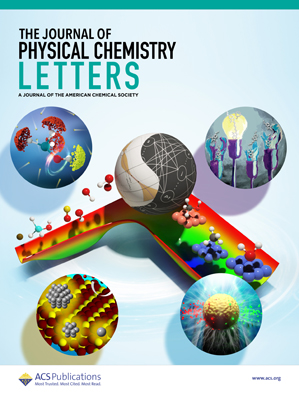尺寸和形状对甲基碘化铅钙钛矿量子点的光致发光和超低频拉曼效应的影响
IF 4.6
2区 化学
Q2 CHEMISTRY, PHYSICAL
引用次数: 0
摘要
甲基碘化铅铵(MAPbI3)量子点(QDs)的光物理性质尚未系统地研究其大小和形状依赖性。本文采用配体辅助再沉淀法合成MAPbI3量子点,通过控制注入速度和反应时间,制备出不同尺寸和形状的量子点。滴注得到约5 nm的球形量子点,在2.06 eV下发出光致发光(PL)。相比之下,快速注入产生更大的(>10 nm)矩形量子点,具有不同的纵横比,由无限量子阱模型支持。与多态MAPbI3薄膜相比,量子点的PL寿命随其尺寸的增加而增加,并且尺寸的变化对81、107和127 cm-1的超低频拉曼模式有显著影响。我们的发现得到了第一性原理密度泛函理论的支持,表明MAPbI3量子点的大小和形状决定了关键的PL和拉曼特性。这项研究有助于理解这些量子点的光学行为,这对它们的潜在应用和环境影响至关重要。本文章由计算机程序翻译,如有差异,请以英文原文为准。

Role of Size and Shape in Photoluminescence and Ultra-Low-Frequency Raman of Methylammonium Lead Iodide Perovskite Quantum Dots
The photophysical properties of methylammonium lead iodide (MAPbI3) quantum dots (QDs) have not been systematically studied for size and shape dependence. Here, we synthesize MAPbI3 QDs using ligand-assisted reprecipitation, controlling the injection speed and reaction times to produce QDs with different sizes and shapes. Dropwise injection yields ∼5 nm spherical QDs, emitting photoluminescence (PL) at 2.06 eV. In contrast, swift injections yield larger (>10 nm) rectangular QDs with varying aspect ratios, supported by an infinite quantum well model. The PL lifetime of QDs increases with their size, and the size variation significantly influences the ultra-low-frequency Raman modes at 81, 107, and 127 cm–1, in contrast to what is observed in polymorphic MAPbI3 thin films. Our findings, supported by first-principles density functional theory, show that key PL and Raman properties are governed by the sizes and shapes of MAPbI3 QDs. This study contributes to the understanding of the optical behavior of these QDs, which is crucial for their potential applications and environmental implications.
求助全文
通过发布文献求助,成功后即可免费获取论文全文。
去求助
来源期刊

The Journal of Physical Chemistry Letters
CHEMISTRY, PHYSICAL-NANOSCIENCE & NANOTECHNOLOGY
CiteScore
9.60
自引率
7.00%
发文量
1519
审稿时长
1.6 months
期刊介绍:
The Journal of Physical Chemistry (JPC) Letters is devoted to reporting new and original experimental and theoretical basic research of interest to physical chemists, biophysical chemists, chemical physicists, physicists, material scientists, and engineers. An important criterion for acceptance is that the paper reports a significant scientific advance and/or physical insight such that rapid publication is essential. Two issues of JPC Letters are published each month.
 求助内容:
求助内容: 应助结果提醒方式:
应助结果提醒方式:


